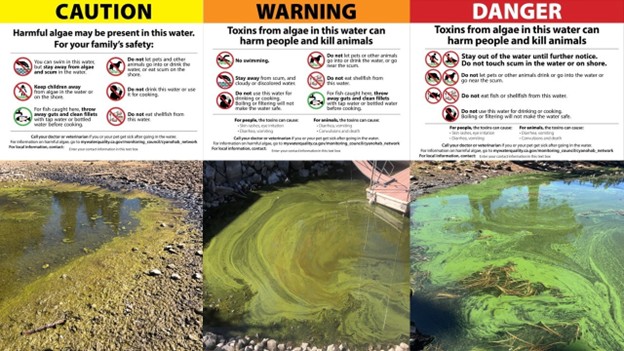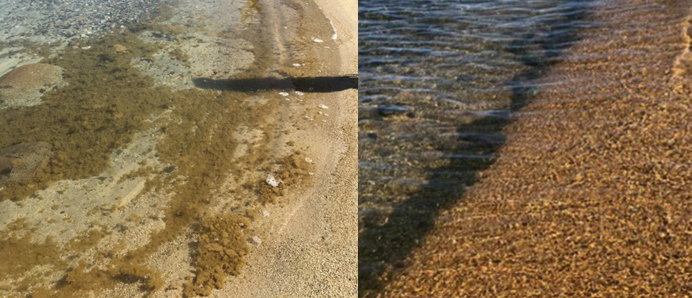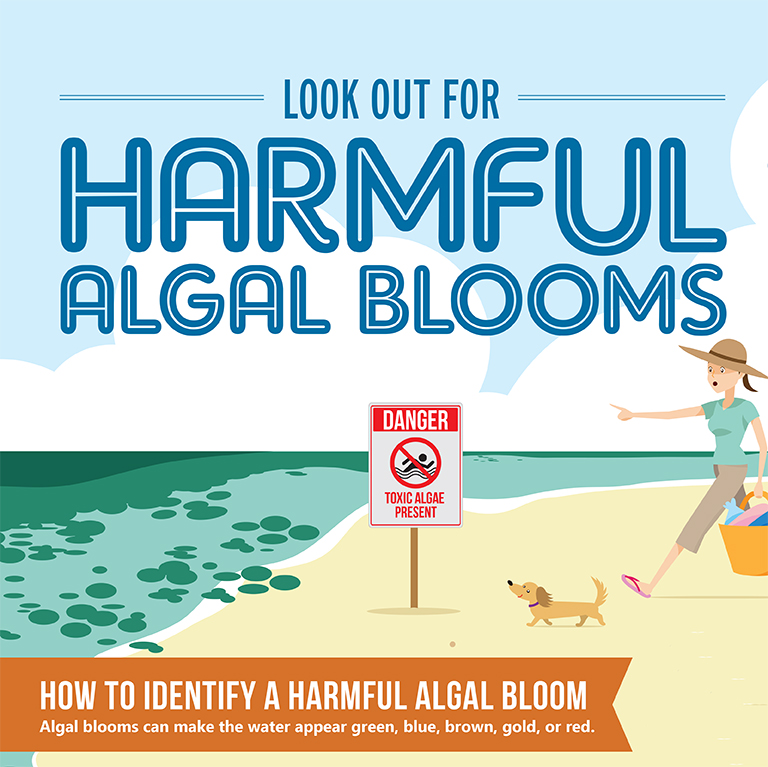SOUTH LAKE TAHOE, Cal., May 22, 2024 – During the summer, algae in Lake Tahoe is a hot topic. While these tiny organisms are a natural part of Tahoe’s aquatic ecosystem, algae can become a harmful algal bloom, or HAB, where the water is warm and shallow. For everyone who enjoys the region’s lakes, rivers, and creeks, it’s important to know how to spot a HAB, where to report your sightings, and what to do to keep yourselves, your pets, and others safe.
A NATURAL PART OF THE ECOSYSTEM
Lake Tahoe is famous for its blueness. The growth and spread of algae is one reason blue lakes around the world can appear green in the summer. Algae forms the base of many food webs, and most algae in Lake Tahoe, though sometimes unattractive, does not pose a health risk to people or animals. Harmful algal blooms are a different story. HABs can be mistaken for harmless types of algae that naturally occur in Tahoe and can be found clinging to rocks, washing up on beaches, and attached to the bottom of creek and river channels. HABs, however, pose a risk to public health and safety as they can produce toxins.
The Lahontan Regional Water Quality Control Board (Water Board) places a focus on algae and HABs in Tahoe’s waterbodies. They are not alone. The Tahoe Science Advisory Council (Science Council), and notably its member the UC Davis Tahoe Environmental Research Center, study the presence, abundance, and distribution of Tahoe’s algae over time and how those characteristics are shifting with climate change. The nonprofit environmental organization Keep Tahoe Blue — in line with its mission to protect the Lake for future generations — supports water quality monitoring and scientific efforts to better understand how algae behave and impact the Tahoe region. Keep Tahoe Blue also encourages everyone who enjoys Tahoe during the summer to be aware of and watchful for HABs.
WHAT IS A HARMFUL ALGAL BLOOM?
HABs are often formed by tiny organisms called cyanobacteria and can make the water a variety of colors such as green, white, red, or brown. HABs may look like thick paint floating on the water or as algal mats in rivers, streams, and along the shallow shorelines of lakes. In lakes, HABs usually appear as a mix of intense shades of green in a paint-like sheen on the water’s surface. In rivers, HABs typically look like algal mats that are attached to the channel bottom. Strong winds, currents, or waves can dislodge algal mats and push them onto shorelines. This guide can help you identify a HAB.
Common factors contributing to algal blooms are warmer temperature, slow or stagnant water, and nutrients in the water that serve as food for algal organisms. Current research suggests that rising temperatures and changing precipitation events associated with climate change may contribute to the increase in the prevalence of HAB. Here’s why:
- Warmer temperatures can propagate algal blooms because many of the cyanobacteria species (the tiny organisms that make up a bloom) are adapted to hot conditions.
- Intervals of drought can contribute to stagnant or slow-moving water, which helps harmful algae grow.
- If extreme rainfall events become more frequent (as they are projected to) stormwater, surface water, and groundwater discharges will deliver more nutrients to water bodies, fueling the growth of HABs.
MONITORING FOR HABs
On the California side of Lake Tahoe, the Water Board tests and monitors water quality, coordinates with land managers, and provides signage to warn the public of risks associated with HABs. The Water Board conducts routine testing at popular and susceptible sites prior to major summer holidays. This season, El Dorado Beach, Regan Beach, Kiva Beach, and Kings Beach will each be tested prior to Memorial Day, the Fourth of July, and Labor Day to inform the public of any potential risks.
Given the history of algal blooms within the Tahoe Keys lagoons, three sites there will also be tested prior to the Fourth of July, Labor Day, and in late September. In addition to scheduled testing, the Water Board also responds rapidly to reports from the public, especially within the Lake Tahoe Basin. You are encouraged to report HAB sightings through this website. The information in this article and this webpage can help you identify and report possible HABs. Current HAB conditions can be found on the Water Board’s HAB webmap, and the public is encouraged to follow HAB-related signage recommendations posted at beaches.
Last summer, Lake Tahoe’s waters were monitored multiple times at various beaches as part of routine testing and in response to HAB reports submitted by the public. No toxins were detected in samples collected from the California side of Lake Tahoe in 2024. The Tahoe Keys lagoons were also monitored at various locations throughout the summer. One sample collected in July showed toxin levels that triggered a Warning advisory which lessened to a Caution advisory level when it was retested in August.
We encourage you to stay vigilant, report HABs when you see them, and follow these healthy water habits. Keep reading to understand the differences between the HAB advisory levels: Caution, Warning, and Danger.
HAB SIGNS AND WHAT THEY MEAN FOR YOU

The Water Board relies on three tiers of signage to inform the public about HABs. From lowest to highest, they are Caution, Warning, and Danger. These signs, or advisories, recommend what you should and should not do in areas experiencing a HAB. Advisory levels typically apply to specific affected areas, such as one beach or portion of a beach, and not an entire waterbody.
Land managers can choose to place Caution advisory signage based on visible observations of algae or HABs, even if the presence of a HAB has not been confirmed by laboratory testing. This is done to warn the public of potential danger, so please be vigilant if signage is posted. Advisory signs may be kept in place after a previously confirmed HAB has dissipated solely for caution.
In addition to Caution, Warning, and Danger advisories, there are also Check for Algae and Algal Alert signs, which you can see here.
PET EXPOSURE
Typically, the algae seen in Lake Tahoe is not harmful, yet it is critically important to stay watchful to keep yourself and your pets safe. Don’t let your trip to the beach end with a visit to the veterinarian.
Animals will often drink fresh water, eat algal material, or lick algal material off their fur after being in the water. Both skin contact and ingestion can cause animals to become sick. These reactions can occur within minutes to days following exposure to cyanotoxins and include symptoms ranging from lethargy and vomiting to rashes and seizures.

Common examples from Lake Tahoe of algae accumulations sitting on the bottom of the water column. Often this algae is not harmful, but if Caution signs are present, you should follow the posted recommendations, including not allowing your animals to swim.
If you believe your animal has been exposed to cyanobacteria, contact a veterinarian as soon as possible. This fact sheet for veterinarians is a useful resource for recognizing, diagnosing, and treating animals for exposure. For additional assistance, contact the 24-hour ASPCA Animal Poison Control Center hotline at (888) 426-4435. (A $65 consultation fee may be applied.)
WHAT YOU CAN DO
First and foremost, stay informed and aware of how to spot a HAB, where to report it, and how to avoid putting yourself, your loved ones, and pets at risk. Use the resources below.
If you think you’ve spotted a HAB, share that information with the Water Board for the California side of the Tahoe Basin, and with the Nevada Division of Environmental Protection for the Nevada side.
- How to identify a HAB
- Report a bloom in California
- Report a bloom in Nevada
- California incident report map
- Nevada HAB dashboard and map
- Nevada HAB current advisories
- How to keep you, your family, and pets safe from HABs
- Frequently asked questions
WE CAN ALL KEEP TAHOE BLUE
Protect the Lake while you play this summer. Here are a few fast, easy actions you can take.
- Clean, Drain and Dry anything that you plan to put in the water. Boats, kayaks, and even fishing gear can transport aquatic invasive species. These organisms outcompete native species and can increase algae growth, leading to HABs and the decline of Lake Tahoe’s famous water clarity. Learn how to properly Clean, Drain and Dry here.
- Share what you see. Visit CitizenScienceTahoe.org to submit sightings of algae, cloudy water, aquatic invasive species, and litter around Lake Tahoe. Scientists review your reports and can respond quickly to ecological threats.
- Become a citizen scientist. Join Keep Tahoe Blue’s Eyes on the Lake program and learn to identify and report aquatic invasive species. Your sightings can keep Tahoe’s blue waters from turning green.
###
Media Resources: Images
Media Contact:
Chris Joseph, Communications Director, League to Save Lake Tahoe
cjoseph@keeptahoeblue.org, 530.541.5388 ext.206
The League to Save Lake Tahoe is the donor-funded, science-based organization of environmental experts and Tahoe-lovers behind Keep Tahoe Blue. We have led the protection and restoration of the Lake Tahoe Basin since 1957 and remain the one organization who brings everyone together for the same goal — to protect Tahoe for future generations. Learn more, donate, and get involved at keeptahoeblue.org.


